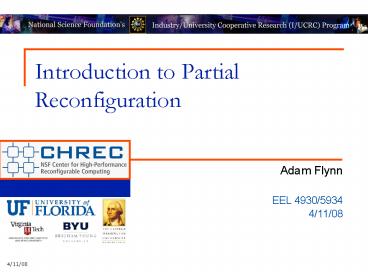Introduction to Partial Reconfiguration PowerPoint PPT Presentation
1 / 13
Title: Introduction to Partial Reconfiguration
1
Introduction to Partial Reconfiguration
- Adam Flynn
- EEL 4930/5934
- 4/11/08
2
Agenda
- Introduction
- Definitions and Acronyms
- Potential Implementations
- Example Applications
- Demo
3
Introduction
- Full Reconfiguration
- Bitfile for entire FPGA is loaded onto FPGA
- Partial Reconfiguration (PR)?
- Only certain portion(s) of FPGA are reprogrammed
- Advantages
- Shorter reconfiguration time
- Less power
- Smaller bitfiles
- Rest of FPGA can remain operational
- Few applications outlined later
4
Definitions and Acronyms
- Partial Reconfiguration Module (PRM)
- Design module that is swapped in and out on the
fly - Partial Reconfiguration Region (PRR)
- Section of FPGA fabric set aside for a PRM.
- A single PRR can have multiple PRMs defined for
it - Base Design
- Static portion of the design everything thats
not a PRM and remains operational during PR - Bus Macro
- Pre-placed, pre-routed macro that locks routing
between PRMs and the base design - How PRM communicates with rest of FPGA
5
Potential Application
Base (Static) Region
PR Region
Bus Macros
- Apply to what weve done so far in class
- Modules A, B, C are memory map, register file,
controller, etc - PRR is Fibonacci Calculator or Accumulator
- Can reconfigure FPGA to implement any function
- Provided function is amenable to standard
interface
6
PR Implementation 1
- Static section controls PRR, provides interface
to system - Access to I/O must go through bus macro
7
PR Implementation 2
8
PR Implementation 3
9
Application A
- Embedded system where FPGA must constantly
communicate with system - Mission critical modules can maintain real-time
links while the functionality of other portions
of the FPGA are reconfigured - Not possible with full reconfiguration
- Reconfiguring PRRs can allow FPGA to
- Implement alternate video coding standard
- Use different radio link protocol/frequency
- Provide hardware acceleration for several kernels
too large to fit onto FPGA simultaneously
10
Application B
- Fault Tolerance
- Useful for FPGAs in harsh environments (i.e.
space) - Configuration bits can become corrupted
- Adaptable Component-level Protection
- Level of Fault Tolerance/Protection can be
reconfigured - See figure for visualization
- Configuration Scrubbing
- Configuration Manager monitors configuration
bits, corrects corrupted bits
Component- level Adaptation
A
B
B
B
A
D
BLANK
A
C
BLANK
no parallel, SCP
2 parallel, SCP
no parallel, TMR
4 parallel, single
SIFT Software-Implemented Fault Tolerance SSCP
Spatial Self-Checking Pair TSCP Temporal
Self-Checking Pair SNMR Spatial N-Mod
Redundancy TNMR Temporal N-Mod Redundancy ABFT
Algorithm-Based Fault Tolerance
11
Application C
- Multipurpose System Design
- Idea Create high level design with several PPRs
- PRRs can be repopulated as application
requirements are defined/change - Provides flexibility
- Does not require designer to anticipate future
upgrades
12
Acknowledgements
- Chris Conger, Ross Hymel
- Borrowed heavily from previous presentations
13
Demo

